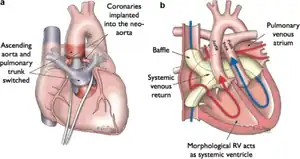Atrial switch
| Atrial switch | |
|---|---|
 | |
| Arterial (left) and atrial switch (right) | |
| Specialty | Cardiology |
Atrial switch is a heart operation performed to treat dextro-Transposition of the great arteries.[1] It involves the construction of an atrial tunnel which redirects the blood coming into the atria to restore the connection between systemic and pulmonary circulation.[2]
Two variants of the atrial switch operation developed – the Senning procedure (1950s) which uses the patient's own tissue (pericardium) to construct the baffle, and the Mustard procedure (1960s), which uses a synthetic material.[3] It has largely been replaced by the arterial switch operation.[3] The operation is more commonly performed in developing countries, where the condition frequently presents late.[4]
References
- ↑ Frandson, Eric; Files, Matthew D. (2020). "99. Transposition of the great arteries". In Raja, Shahzad G. (ed.). Cardiac Surgery: A Complete Guide. Switzerland: Springer. pp. 735–748. ISBN 978-3-030-24176-6.
- ↑ "d-Transposition of the Great Arteries". www.heart.org. Archived from the original on 22 January 2022. Retrieved 25 October 2022.
- 1 2 Prokšelj, Katja; Brida, Margarita (18 July 2022). "Atrial switch operation for transposition of the great arteries: tricuspid regurgitation matters". Heart. doi:10.1136/heartjnl-2022-321398. ISSN 1355-6037. Archived from the original on 25 October 2022. Retrieved 25 October 2022.
- ↑ Talwar, Sachin (July 2016). "Atrial switch procedure in children more than 5 years of age: mid-term results". Interactive CardioVascular and Thoracic Surgery. 23: 694–698. Archived from the original on 2022-01-25. Retrieved 2022-10-25 – via Oxford Academic.
This article is issued from Offline. The text is licensed under Creative Commons - Attribution - Sharealike. Additional terms may apply for the media files.